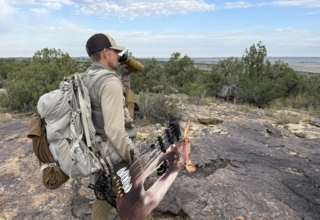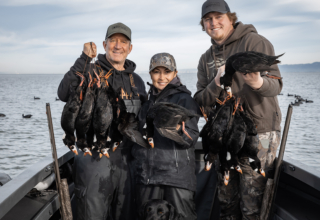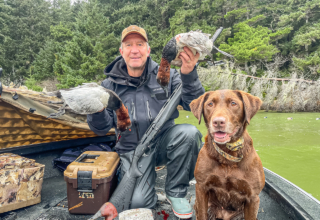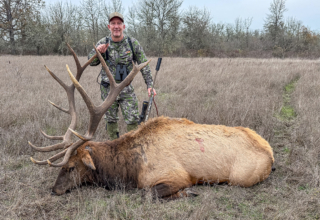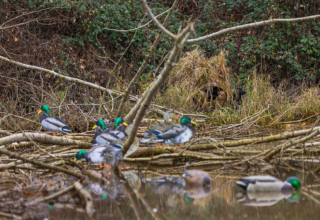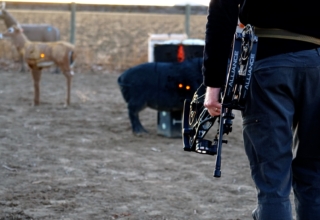The author and friends put Browning’s all-new A5 20 Gauge to the test in remote Alaska.
by Scott Haugen
White wings erupted, catching me off guard as I staggered from one tussock to another. With my body shifting left, shouldering the gun mid-stride, and swinging right was easy. But the willow ptarmigan kept turning, hard.
My first shot wasn’t even in the same time zone as the speedy bird. Feet set, shoulders somewhat squared, the next shot was solid. The bird rolled on the tundra. I’d just shot my first bird with Browning’s new A5 20 gauge. The quick handling and speedy recovery with this gun after my first, off-balance shot, got my attention.
The next covey flushed straight away. Those shots were simple. A double fell from that flush.
Over an hour would pass before my buddy, Rafe Nielson, and I would get on another flock of tundra grouse. By then, the wind was moving, holding steady at 20 mph with gusts far exceeding that. Birds were edgy, holding on the backside of open points, out of the wind.
Masters of disguise, willow ptarmigan in summer plumage can be impossible to see unless they move. Though their wings are white year-round, they tuck them into their body when on the ground. Sometimes they hold tight, not flushing until you’ve nearly stepped on them. Other times, they see you coming from a quarter mile away and take off. Windy conditions put ptarmigan on edge, and hunting them on open tundra is far from easy.
We covered just shy of six miles that afternoon. And while we had enough birds for appetizers, we knew, given the forecasted windy conditions, we had our work cut out for us the rest of the week.
Alaska’s Egegik River
We were on the upper end of the Alaska Peninsula, along the banks of the Egegik River. We were on a cast and blast adventure with Becharof Lodge, which I first visited 19 years ago. I’ve been going back nearly every year since, both for the coho fishing and ptarmigan hunting action.
I’ve taken some dandy brown bears in this area over the years, along with big bull moose. The wildlife viewing is spectacular. It’s a part of Alaska that’s very dear to me, and I’ve covered much of the state in the last 35 years, having lived there for almost a decade.
The next morning, we were up early, hitting the river for coho. After a couple of solid hours of fishing, we grabbed our Browning A5 20 Gauge models and hit the tundra. Bird hunting here is self-guided, adding to the overall joy and adventure.
However, this summer, the berry crop was overall lacking. Crow berries abounded within a few hundred yards of the river, but inland, they were void. An unseasonably dry summer squelched any berry propagation. Low bush cranberries were almost non-existent, and I didn’t see a single salmon berry or blueberry. Typically, blueberries blanket the tundra for several square miles.
Nonetheless, ptarmigan numbers were high, about as good as I’ve seen them in nearly 15 years. We only jumped a few flocks as they fed on crow berries and green leaves. Most birds we encountered were seeking shelter from the heavy winds, and finding birds required walking.
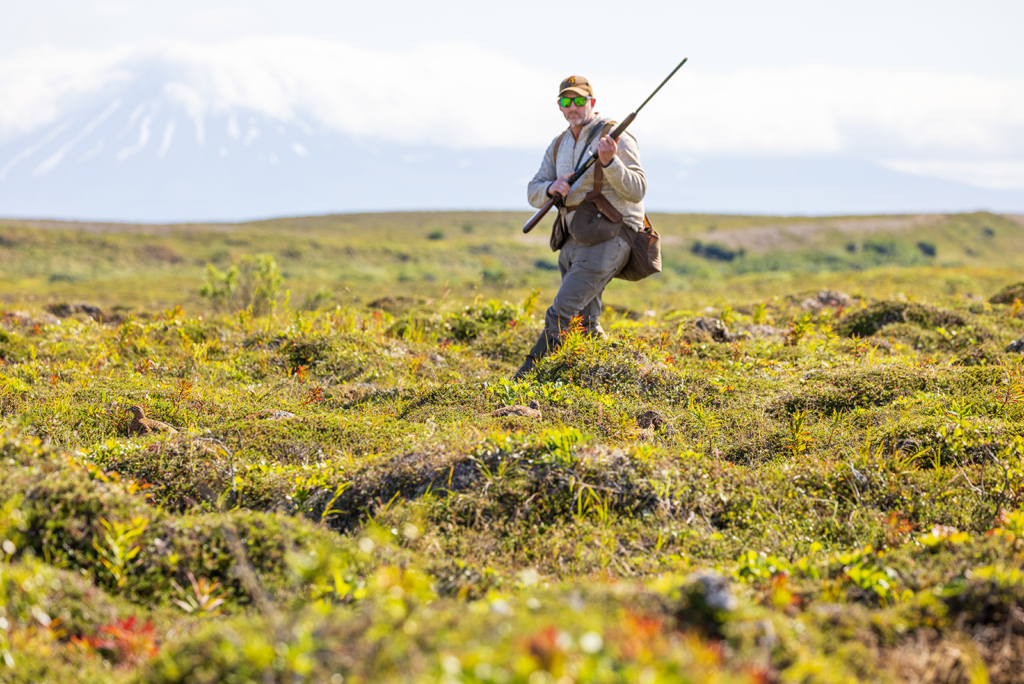
Of all the habitats I’ve traversed around the world, the tundra is the most taxing on the body. The more wet and soggy the tundra, the harder it is to negotiate. It makes packing moose, caribou, and big brown bears extremely hard. Simply walking on the soft, uneven ground takes a toll on the body. No terrain engages every muscle like the tundra. From your feet to your shoulders, fighting for balance, maintaining timing, and especially shouldering and swinging a shotgun at fast-moving targets, is pushed to the limit when traversing the tundra.
Browning’s A5 20 Gauge
The Browning A5 20 gauge is an inertia gun. It weighs only 5 pounds 9 ounces. Hiking with it every day was simple; never a burden. In fact, toting it all day was effortless, as was handling and swinging the lightweight beauty on speedy birds.
A smaller aluminum receiver on this recoil-operated Kinematic Drive System shotgun, along with its streamlined design, equates to speed and consistency in every handling aspect. I ran a lot of shells through the A5, and I was rarely squared up. Ptarmigan are fast, meaning quick, reactionary shooting is a must. Opportunities must be seized instantly or forfeited. I know there were shots I made with the A5 that I could not have pulled off with a heavy double-barreled shotgun. And face it, having that third shot is a bonus, primarily when covering miles and spending hours tromping the tundra every day.
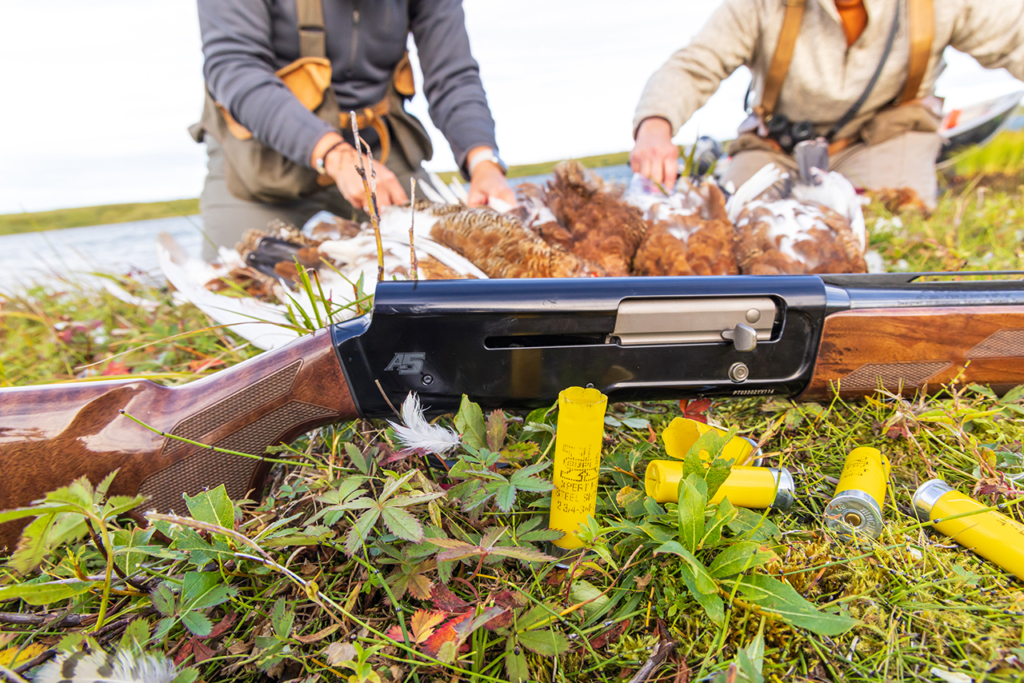
I’ll be the first to admit I struggle shooting the A5 12 gauges for waterfowl. For that job, I prefer a Maxus II. But something about chasing upland birds with the bantam A5 20 gauge was noticeably different. I got on birds fast and connected on a high percentage of shots; some even surprised me.
For A Full Review of Browning’s MAXUS II, CLICK HERE!
No doubt the iconic humpback receiver of the A5 20 gauge delivered precise and direct eye-to-sight contact, making for rapid target acquisition. In fact, the squared receiver acted as a block, allowing me to focus on each moving target quickly. The optical perspective and sight alignment are streamlined, making for smooth, natural swings, shots, and follow-through. It made shooting fast and easy.
We were hunting on a refuge, requiring the use of nontoxic shot. While Winchester’s Game & Target high-velocity 2 3/4-inch steel 6-shot was the primary load I shot for ptarmigan, I also ran 3-inch bismuth and tungsten super shot through the A5 20-gauge. Each load shot and patterned very well. I was incredibly impressed with the TSS’s performance in high winds and on long-range shots.
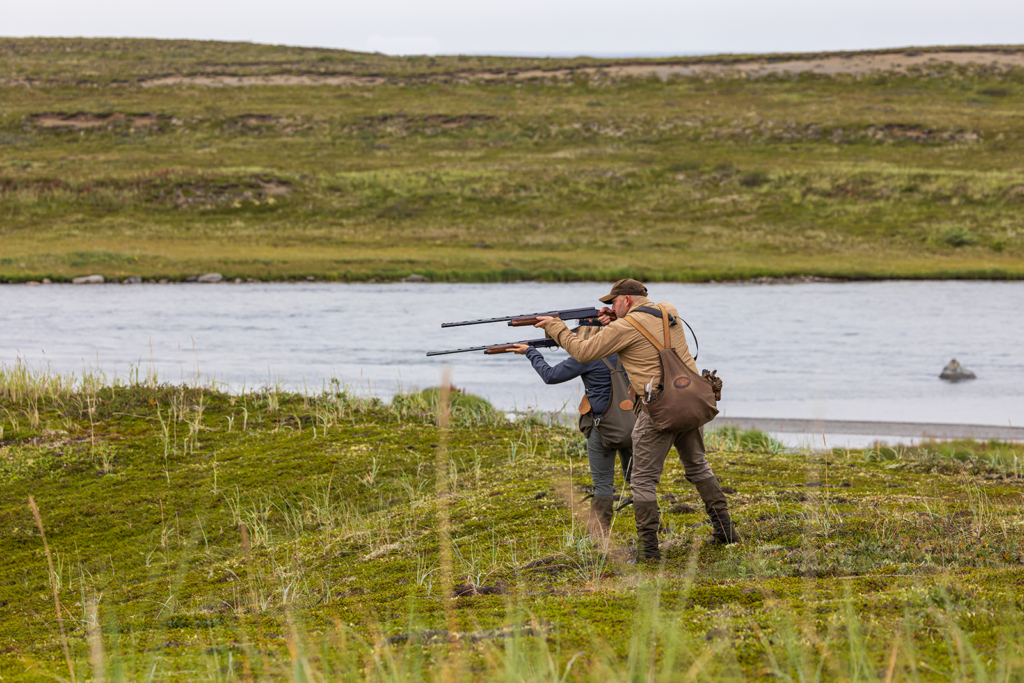
We hiked over six miles each of the next four days, and logged eight miles one day. All but one of those days saw us facing winds of 30 mph or more, with even heavier gusts. Shooting conditions were far from easy. The conditions and the birds were the ultimate test for the A5 20 gauge.
The Hunt
After catching a limit of coho one morning, Nielson and I were on a mission to secure limits of ptarmigan. Killing 10 birds each wouldn’t be easy, not in the challenging conditions, and given the fact that we agreed to shoot everything on the wing.
Sustained winds of 30 mph prevailed. While ptarmigan might flush into a headwind, they’re quick to turn, making for some of the most challenging upland shooting imaginable.
One single jumped too far in front of me to shoot. But it banked hard, picked up some wind currents, and instantly circled behind me. Nielson shouldered his A5 and made the best shot I’ve ever seen on a speeding ptarmigan. With the wind, that bird had to be moving over 35 mph, yet Nielson dropped it with one beautiful shot, and that, following a long swing.
After three miles of hiking, we ran out of crowberries. Figuring the ptarmigan would be hunkered down in the sporadic smattering of willows, we split up. Nielsen hunted the south shoreline of a 15-acre pond sunken in the tundra. I skirted the northern edge. Nielson picked up a brace of ptarmigan. I put the move on a family flock huddled on the backside of a barren knoll. Cresting the rolling hill, the instant I popped into view, the ptarmigan took wing. Quickly, I raised, picked out a plump bird, and fired. It fell. The flock turned away. Two more shots saw a pair of ptarmigan drop.

An hour later, the wind was still howling. Rain began to fall. Figuring that was the break we needed to concentrate birds, we focused hunting efforts around tall stands of willows, about four miles from the river. We counted over 400 birds in a short time, but they were already part of growing winter flocks, some comprising over 50 birds. The many eyes made for challenging hunting, as the birds were already on edge. Almost every bird we saw took off well before we could move into shooting range. After many frustratingly failed encounters, we hiked back to the river, hoping to find ptarmigan in low spots, where they would be feeding out of the wind. The move paid off. Soon, we were cleaning limits of ptarmigan.
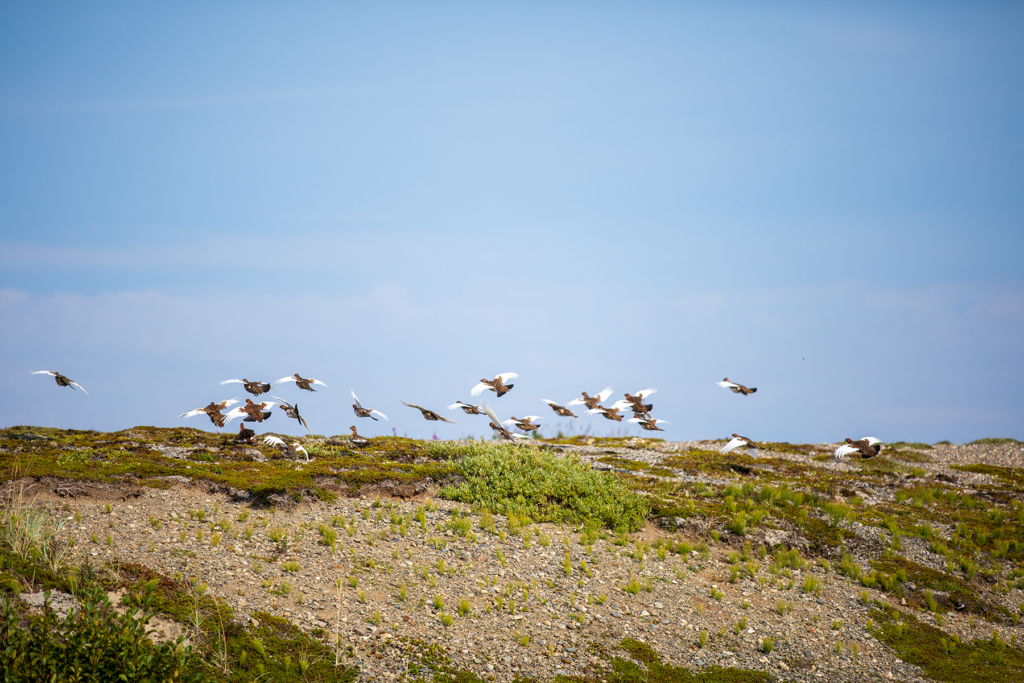
That night, we shared our bounty with others in camp. Early season ptarmigan is about the best eating upland bird you’ll ever sink your teeth into. And yes, I’ve tasted many pheasant, chukar, forest grouse, and quail.
The next morning, we were back on the Egegik River. Nielson put the smackdown on some hefty coho with his fly rod, on flies he tied himself. I caught my five fish limit casting spinners. By 10:00 a.m., we were hiking across the tundra, A5s in hand, trying for another cast and blast double.
Not only had I struggled shooting A5 12 gauges over the years, but inertia guns have left me flustered more than once. But this new little sub-gauge caught my attention. Putting several rounds through it without a hiccup, and seeing its performance after five days of hunting in the rain and driving winds with only a wipe-down and barrel swab, left me optimistic. The easy handling and ability to quickly acquire fast targets made me want to shoot the A5 20 gauge even more.
I look forward to using it on other upland hunts this season, as well as in the duck blind.
Becharof Lodge On The Egegik River
Becharof Lodge specializes in coho fishing on the Egegik River. With a five salmon limit per day, going home with 50 pounds of fresh fillets is the norm.
Ptarmigan numbers can be cyclical. On up-years, Becharof Lodge offers do-it-yourself ptarmigan hunts. Take off on foot from the lodge. Once you leave Native Corporation Land and enter the refuge, it’s wide open.
Becharof Lodge has two 20-gauge Citori shotguns and a .410 shotgun for clients to borrow. Bring a couple of boxes of nontoxic shotgun shells and be ready to walk. While shooting limits are never a guarantee, you’ll get plenty of opportunities, see some breathtaking land, and come away with a cast and blast experience you’ll never forget.


